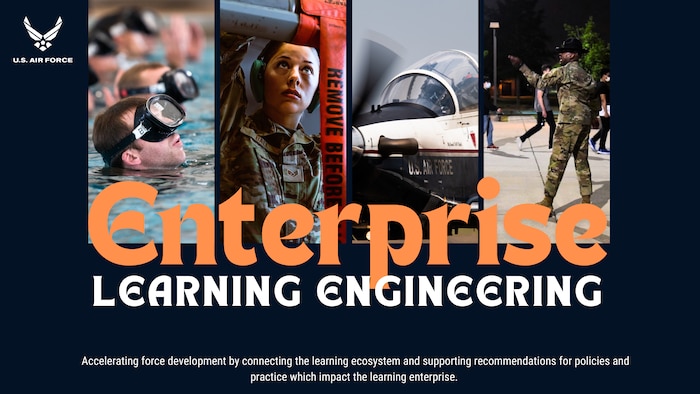In support of Air Education and Training Command's intent to soon redesignate as Airman Development Command, the command is planning to realign portions of the headquarters staff to establish the Enterprise Learning Engineering Center of Excellence to directly support development and delivery of mission ready Airmen and Guardians to joint force commanders with the competencies needed to deter or defeat great power competitors.
As a critical component of AETC's efforts to follow through on the Department of the Air Force's reoptimization for Great Power Competition, the ELE CoE will be designed to enhance learning engineering and accelerate learning and retention for students, faculty, and staffs across the DAF.
"The ELE CoE is designed to accelerate force development by connecting the learning ecosystem and supporting recommendations for policies and practice which impact the learning enterprise," said Dr. Wendy Walsh, AETC chief learning officer. "The team's structure provides the DAF a theoretically grounded method to continuously improve and innovate learning across the Department of the Air Force through the lens of operational readiness and the Air Force Future Operating Concept."
According to Walsh, Learning Engineering is an interdisciplinary approach that prioritizes human-centered design and the use of evidence-based practices supported by rigorous research and empirical data. Learning Engineering applies principles from various domains such as education, cognitive science, data analytics, technology, and engineering to optimize learning experiences and outcomes.
The ELE CoE will be dedicated to the systematic application of evidence-based principles, scientific methods, and practices from the learning sciences, education research and systems-thinking to produce effective, Airmen-centered learning outcomes and competency acquisition, Walsh said.
As an advisor to the future ADC commander, and guided by the chief learning officer, the ELE CoE director will lead an interdisciplinary cross-functional team of approximately 24 full-time learning professionals, analysts, researchers, and military leaders employing a diverse set of educational and development skills and experiences.
The ELE CoE will conduct the following core functions:
- Experiment and Field-Test Learning Technologies and Methods
- Develop/Integrate Cross-Functional and Interdisciplinary Learning and Training Tactics, Techniques, and Procedures Lead Faculty Development and the Scholarship of Teaching and Learning Activities
- Collaborate and learn with Industry/Academia/Joint Team
- Dynamic Competency Development Methodology and Governance
- Determine Capability Gaps and Science and Technology Interoperability
- Learning Management System/Student Information Systems Data Standards and Governance
- Learning Data Management, Analysis, and Integration
- Human Performance Integration
- Hosting Interdisciplinary Focus Groups
The ELE structure will enable interdisciplinary 'Standing Teams' focused on enduring missions and requirements, as well as 'Task Teams' established for a fixed duration to meet an emerging mission or task. "These task teams will function as smaller cells and incorporate advisory support and guidance from both internal and external agencies to reveal the most effective solutions," said Col. Paul Swenson, AETC's ADC Operational Planning Team co-lead. "Members of the ELE CoE will simultaneously work within one or more standing teams, and likely support multiple task teams at any given time."
The ELE CoE will also serve as the primary focal point to coordinate and/or execute sustained Airmen-centric development by leveraging and collaborating with the associated 2nd and 19th Numbered Air Force Centers of Excellence, innovation communities, private industry, interagency, and academia partnerships.
"We must foster a robust learning ecosystem with enhanced communication and collaboration among internal and external stakeholders, industry partners, and academic institutions to integrate new technology, broadly consider constraints, and apply scientific thinking to generating learning investments and architectures that result in mission impact," Walsh said.
Understanding early integration opportunities with other DAF institutional and operational commands will ensure viable learning outcomes, data interoperability, and security are factored in new technology acquisition before they are purchased.
"The ELE CoE will actively work with AFWERX, Spark Cells and others to seek out learning innovations that could be adapted to advance DAF missions," Walsh said. "The ELE CoE will network and partner with a variety of agencies to facilitate testing and evaluation of emerging technologies and seek methods to scale emergent capabilities."
In practice, this means the ELE CoE will build networks with learning organizations to identify opportunities and challenges, collaborate on test environments to verify and validate capabilities, address cost drivers, and create clearer communication regarding security, requirements, and acquisition for learning hardware and software technologies being developed by industry, academia, and coalition partners.
While there is innovative work happening across the command, avoiding the pitfalls of working in "silos of excellence" is critical to the future of Airman development, Walsh said.
"These networks allow us to collaborate on resources to test and field technology, advance learning science, communicate lessons learned, eliminate duplication of effort, and showcase best practices in an agile, fast-paced environment," Walsh said. "We will also partner with experts in human performance to maximize the potential of the human weapon system by employing a holistic, domain-focused approach to competency development."
DAF senior leaders outlined changes to AETC in February at the AFA Warfare Symposium in Aurora, Colorado, as part of the service's 24 key decisions designed to meet the challenges of a changing threat environment, keep the force competitive, and enact urgent change. These decisions are broadly grouped into four categories - Develop People, Generate Readiness, Project Power, and Develop Capabilities. AETC was designated as the lead command responsible for the future of DAF-wide personnel development.
Additional details about ADC implementation will be released when they are available. Currently, ADC congressional notification requirements are pending.







